Places to Visit in Junagadh captivate travelers with an exquisite tapestry of history, spirituality, and natural beauty. Nestled at the foothills of the Girnar hills, this ancient city unveils relics of bygone eras, serene temples, and vibrant wildlife. From wandering through age-old forts to observing exotic animals at the Sakkarbaug Zoo, every corner of Junagadh tells a story. Whether you’re seeking a spiritual retreat at the foot of Mount Girnar or looking to explore the city’s erstwhile grandeur, Junagadh’s diverse attractions offer a profound journey through time.
Unveiling Junagadh’s Historical Tapestry
Junagadh, a jewel nestled in Gujarat, India, during the era of British India, offers a rich tapestry of history and heritage. Boasting an eclectic mix of monuments that bear the signatures of Hindu, Islamic, and colonial influences from the British period, the city is an archival treasure. Among these, the Girnar Ashoka Rock Edicts stand as a prominent historical landmark on the Junagadh Rajkot highway, revealing the profound legacy of Emperor Ashoka. Not far from the city center, hallowed shrines like the shrine at Dataar Hills add to the spiritual allure of Junagadh. Guests to this city will find themselves entranced by the lore and the legacy etched into the very stones and landscapes.
- Opulent Palaces: Marvel at the grandeur of former royal residences, embodying the rich history integral to Junagadh and nearby regions as well.
- Imposing Forts: Explore ancient forts that tell tales of the past, including the narratives of the Nawabs of Junagadh and their conservation efforts for the Asiatic Lions.
- Hallowed Temples: Visit sacred temples with deep historical significance, like the renowned shrine of Jamiyal Shah Datar atop Dataar Hills, and resonate with the spiritual heritage of the area.
- Historic Edicts: Discover rock inscriptions and ancient texts that offer insights into bygone eras, including the esteemed Ashoka Junagadh inscriptions, which are a testament to India’s enduring history.
Top 18 Tourist Places in Junagadh: A Blend of History, Culture, and Nature
1. Girnar Hill (Girnar Abode) – Sacred Site with Temples and Panoramas
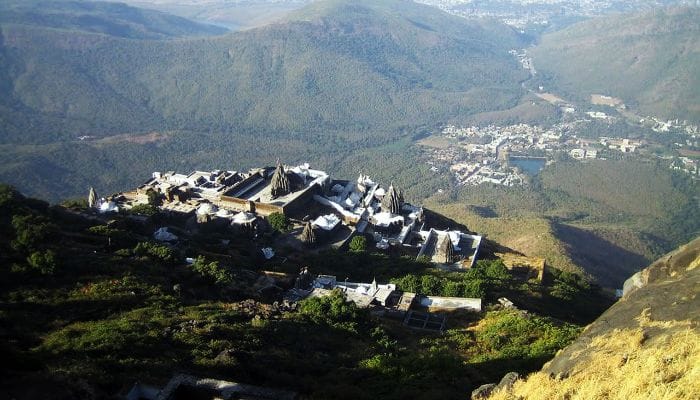
Girnar Hill reigns as one of the premier trekking places, a spiritual skyscraper, with its peak punctuated by an array of sanctified temples drawing in both Hindu and Jain devotees. Those who make the pilgrimage to this temple town are richly rewarded not only with blessings but also with breathtaking views that encompass the entirety of Junagadh from the Dataar Hills.
Among the many sanctuaries that adorn this elevation, the Goddess Ambe Temple stands out as a beacon of maternal divinity, inviting worshippers to experience its profound spiritual resonance. A little further, the Dattatreya Temple provides a serene atmosphere, bestowing a sense of peace upon its visitors. It’s a journey as transformative as it is challenging, promising an unforgettable experience for those who reach its zenith. [Include image of the Girnar Hill temples and panoramic views]
2. Damodar Kund – Sacred Waterbody with a Serene Ambiance

Damodar Kund is a pilgrimage site with a tranquil environment, positioned as a peaceful oasis and one of Gujarat’s most visited sites. This sanctified pond, also Damodar known as a damodar kund water reserve, is flanked by meticulous ghats where pilgrims perform rituals and find solace. A site of spiritual significance, it embodies a legacy where celestial beliefs intertwine with terrestrial comfort. It’s not just about the holy dips by worshippers; the Kund also attracts visitors seeking moments of stillness amidst their bustling lives. #IMAGE# The presence of the Damodarji Temple adds to the sanctity, making it a can’t-miss stop for those intrigued by the tapestry of faith and culture.
3. Ancient Uperkot Fort – Impressive Fort with Stunning Views
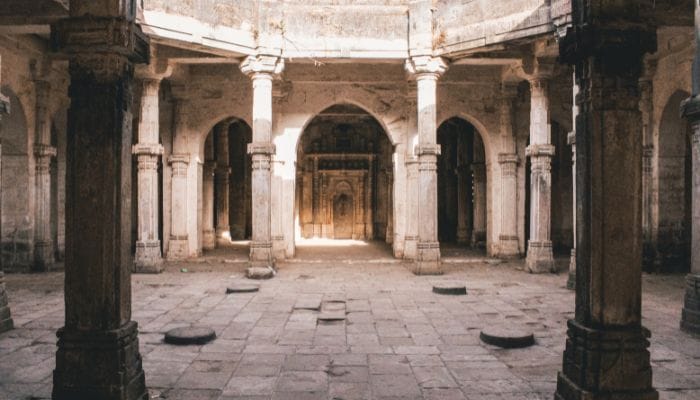
The Uperkot Fort, perched with commanding elegance in Junagadh, is a historical sentinel that has withstood the tests of time. Nestled in the Junagadh district, and located just 1 km from the city center, the fort is ranked #8 of 18 Places to Visit in Junagadh according to Go Heritage. Its ancient historical landmark’s origins date back to 319 BC and offer visitors a fascinating glimpse into India’s ancient martial architecture, right in the heart of Uparkot.
The fortifications, some reaching an imposing height of 20 meters, speak of a bygone era’s strategic prowess, incorporating a deep moat that once deterred invasions with its resident crocodiles. Currently, travelers can explore the premises, where they are free to wander through the fort’s remnants, climb its battlements, and absorb the breathtaking views of the Junagadh district below, making it a must-see for anyone with an appreciation for history and panoramic landscapes.
4. Historical Adi-Kadi Vav – The Step Well of Yore

Adi-Kadi Vav is an intriguing part of Junagadh’s historical landscape, famed for its architectural prowess and the legends that shroud it. This stepwell, hewn directly from the rock, presents a fabulous feat of engineering from the 15th century. A descent of 120 steps takes you to the vav’s heart, where the play of light and shadow upon the stone creates a hauntingly beautiful atmosphere. Visitors are drawn to this site not just to admire its form and function but also to contemplate the folklore that echoes off its ancient walls. Free to explore, this stepwell is a silent narrator of the ingenuity and the mysteries of a bygone era.
5. Remarkable Navghan Kuvo – A Step Well to Remember

Navghan Kuvo, another impressive step well in Junagadh, stands as a testament to the ancient water conservation methods of India. Carved from a single monolithic rock, the structure plunges roughly 52 meters deep, illustrating the masterful stonework of the time. It’s a site where the navghan kuwo junagadh flourish together, as it’s known far and wide for its architectural splendor. Its historical importance is matched by its architectural beauty, with visitors marveling at how something so functional can also be teeming with aesthetic value. With no entry fees and daily availability, Navghan Kuvo offers a spellbinding insight into survival strategies from centuries past and is a must-visit for enthusiasts of heritage and sustainable practices.
6. Majestic Mahabat Maqbara – A Mausoleum of Diverse Architectural Styles
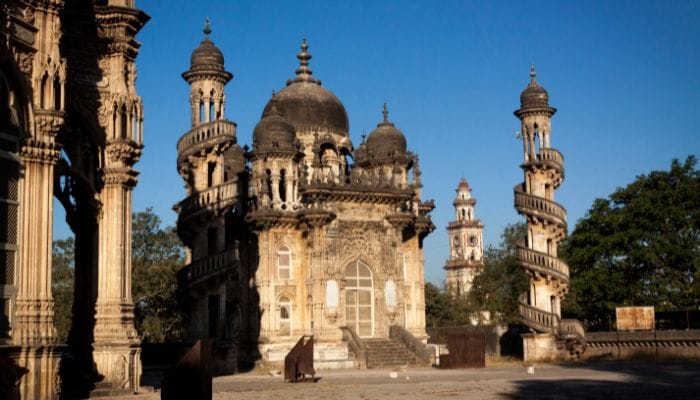
Mahabat Maqbara stands as an architectural masterpiece in the heart of Junagadh, fusing European, Islamic, and Gothic design elements into a symphony of stone. Built in the late 19th century, the mausoleum captivates with its intricately carved silver doors, winding staircases, and finely detailed arches. The minarets that tower over the structure seem to reach for the heavens while the stone carvings tell tales of a regal past. Open 24 hours and free to the public, visitors can immerse themselves in the magnificence of the Maqbara at any time, finding themselves swept away into an era of Nawabs and their opulent artistic sensibilities.
7. Jama Masjid’s History – Mosque with an Impressive Design

Jama Masjid, or the Friday Mosque, is an emblematic vestige of Junagadh’s glorious past, standing at the junction of history and culture. Erected in 1423 under the behest of Ahmed Shah, its impressive Indo-Islamic architectural design captivates onlookers, distinguishing it as a crown jewel of the region’s cultural heritage. Beyond an active place of worship, its use of indigenous yellow limestone and intricate carvings exemplify 15th-century craftsmanship. The mosque offers visitors a peaceful retreat from the bustling city streets, inviting them to experience a moment of repose through prayer or contemplation within its hallowed chambers.
8. Wildlife at Sakkarbaug – Zoological Garden Home to Lions
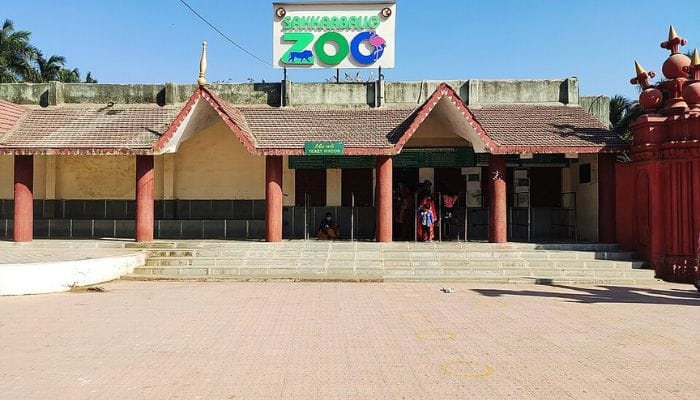 Image Source
Image SourceSakkarbaug Zoological Garden, often dubbed the Junagadh Zoo, provides wildlife enthusiasts with a rare glimpse of the majestic Asiatic lions within a carefully curated environment dedicated to their conservation. Nestled in the vibrant Junagadh district, this zoological park stands as a testament to the region’s rich biodiversity and heritage. As one of the most captivating tourist attractions in the region, the zoo is a sanctuary for a variety of species. Not limited to big cats, the zoo is home to a diverse array of wildlife, including antelopes, wild boars, and blue bulls.
Reviewed enthusiastically by visitors like 618amits on Tripadvisor on 26 May 2022, the zoo’s commitment to wildlife is clear. It also features a natural history museum and a veterinary hospital, indicative of its commitment to education and animal welfare. Perfect for a family outing, visitors can watch these regal beasts—where healthy lions, tigers, and even white tigers and leopards can be seen—in their naturalistic habitats, all while contributing to the preservation efforts that sustain them. Visitors at Sakkarbaug Zoological Gardens can also delight in its proximity to the Gir Forest National Park and appreciate the convenience of connecting through Junagadh Junction railway station, adding a thrilling dimension to an enriching itinerary.
9. Regal Sakkarbaug Palace – A Glimpse into Royal Residence
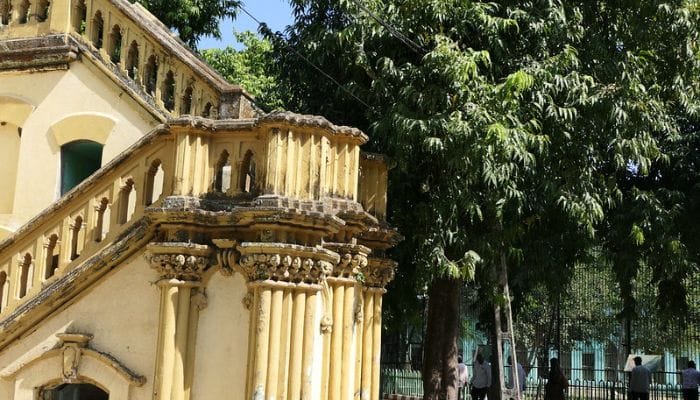 Image Source
Image SourceSakkarbaug Palace, a regal remnant of Junagadh’s aristocratic past, was once the abode of the Nawabs who governed the region. Notably, this city has been a prominent seat for the Jadeja rulers, known for their patronage and architectural contributions since the early 17th century. Having witnessed an illustrious history, the palace now hosts the Darbar Hall Museum. Its galleries, resplendent with the grandeur of the 19th century, exhibit royal artifacts which include weapons, palanquins, photographs, and even the Nawabs’ personal possessions. The museum’s intricate design and historical displays captivate the imagination, inviting visitors to step back in time and experience the opulence that once defined the lives of Junagadh’s ruling class.
10. Sasan Gir National Park – The National Park’s Lion Sanctuary

Sasan Gir National Park is the celebrated sanctuary that has become synonymous with the conservation of the Asiatic lion, providing the backdrop for a thrilling wildlife adventure. Celebrated not only as a pivotal wildlife haven within the junagadh district, but also as the royal cradle of the Asiatic lions, Gir National Reserve is a testament to biodiversity preservation. The park extends beyond mere sightseeing; it offers the chance to be a part of wildlife conservation in action. With guided safaris, one can marvel at the grandeur of lions, leopards, hyenas, and various deer species in their native ecosystem.
Moreover, being strategically located in the junagadh district, Sasan Gir is just a prelude to the area’s rich natural heritage. For those yearning for a deep engagement with wildlife preservation, the Sasan Gir National Park stands as a bastion of both respect and awe.
11. Flourishing Flora at Moti Baug
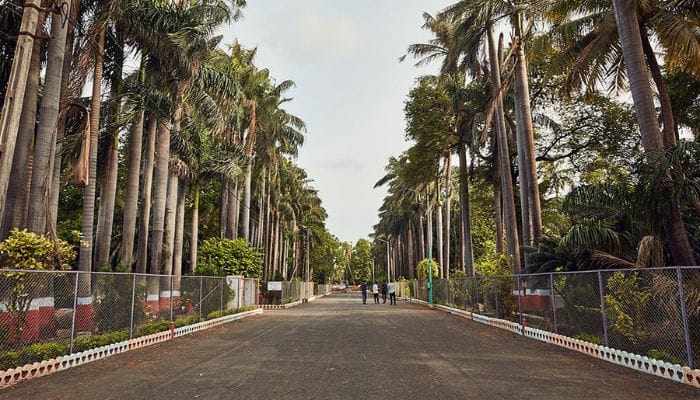 Image Source
Image SourceMoti Baug serves as an oasis of serenity within the bustling cityscape of Junagadh, reminiscent of the serene vibes one might find in the sacred town of Ambaji. Tucked within the grounds of Junagadh Agricultural University, this botanical garden brims with verdant lawns and vibrant arrays of flora. Moti Baug, with its incredible plant diversity – akin to the spiritual diversity at Ambaji – including a multitude of shrubs and flowering species, is an idyllic spot for botanical enthusiasts and casual visitors alike.
The Pari Talav, a picturesque lake within the garden, reminds one of the peaceful waters near the Ambaji temple, and complements the greenery, adding to the park’s enchanting ambiance. Those in search of tranquility, much as they would in Ambaji, will find the garden’s environment refreshingly peaceful, a setting that is both aesthetically pleasing and soul-soothing.
12. Ashoka’s Edicts – A Timeless Historical Record
 Image Source
Image SourceThe Edicts of Ashoka stand as a remarkable historical chronicle etched upon the massive boulders at the foot of Girnar Hill. These inscriptions date back to 250 BC when Emperor Ashoka, overcome by the horrors of war, embraced Buddhism and sought to disseminate the message of dharma (moral law). Specifically, the Girnar Ashoka Rock Edicts in Junagadh are a notable heritage site, where one of the most important sets of these edicts is found. The ashoka junagadh edicts provide a profound glimpse into the moral and ethical imperatives adopted by the emperor. Visitors to Junagadh can immerse themselves in ancient India’s philosophical heritage at this location and reflect on timeless messages that resonate across millennia.
13. Ancestral Buddhist Caves – Preserving Ancient Heritage

The Buddhist Caves in Junagadh represent the spiritual craftsmanship of ancient monks, who carved out these sanctuaries from sheer rock faces. The oldest among these, Kapra Kodia Caves, showcases plain austerity and is believed to date back to the 3rd or 4th century AD, likely patronized by Emperor Ashoka himself. Enriched by the Nawabs of Junagadh and the princely states of nearby areas, these relics of a contemplative past offer a unique look into the ascetic lives led by the monks who once dwelled within their walls. Visitors can capture the essence of a long-vanished Buddhist culture and marvel at the simplicity and harmony with nature that these caves embody. #IMAGE#
14. Bhavnath Fair’s Cultural Kaleidoscope – Festivity and Traditions
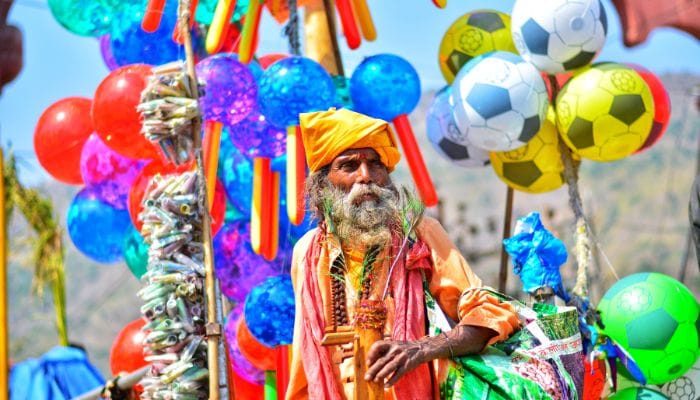 Image Source
Image SourceThe Bhavnath Fair, a vibrant event steeped in mythology and tradition, unfolds not only at the Bhavnath Mahadev Temple but also draws parallels with the Jatashankar Mahadev Temple, both revering Lord Shiva during the auspicious occasion of Mahashivaratri. This five-day festival attracts scores of pilgrims from across the country who gather to celebrate Lord Shiva’s glory with unbridled devotion. The fair is particularly renowned for the Naga Bavas, or naked sages, who emerge to take a sanctified dip in the holy Mrigi Kund before leading the Mahashivaratri procession. Those attending the fair are treated to a confluence of cultural activities, including folk music, dance, and traditional rituals, offering an authentic experience of Gujarati heritage at its most exuberant.
15. Mount Girnar’s Spiritual Journey – Temples Soaring Skyward

Mount Girnar emerges from the plains of Junagadh as a monumental pilgrimage site, its slopes dotted with centuries-old temples that draw devotees from the Jain and Hindu communities. This mountain is revered particularly for its association with the 22nd Jain Tirthankara, Neminath, and its summit promises not just spiritual enlightenment but a peerless natural vista. The arduous climb of over 10,000 steps is a testament to the pilgrims’ faith and determination, as they ascend to pay homage to the gods residing atop. The annual Lili Parikrama, a significant religious foot march around the base of the mountain, further adds to the sanctity of Mount Girnar as a focal point of devotion and worship.
16. Scenic Willingdon Dam – Serene Reservoir and Picnic Favorite
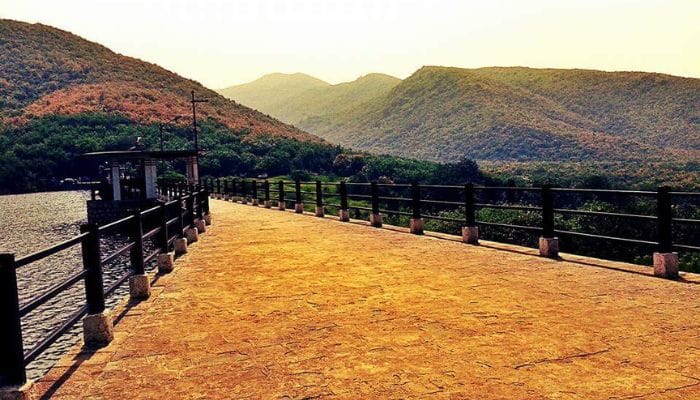 Image Source
Image SourceWellington Dam, also known as Willingdon Dam, is a picturesque reservoir nestled amidst the breathtaking foothills of the Girnar Hills, near Junagadh. This serene escape from city life is a favorite for both locals and tourists, often listed amongst the top places to visit in Junagadh. As you meander along its banks, the panorama of the tranquil waters set against the rugged terrain offers a sense of peace. Built on the Kalwa River, Wellington Dam is not only a tranquil spot but also a key source of water for domestic and commercial use in Junagadh.
When monsoons grace the region, the dam’s overflowing waters morph into enchanting waterfalls, adding to the charm of the location. Photographers and nature enthusiasts find a muse in the spectacle of the sun setting behind Wellington Dam, creating captivating silhouettes that are a must-capture during your visit. [ Include image of Willingdon Dam, the waterfalls during monsoon, and the sunset scenery]
17. Jamjir Waterfall’s Spectacular Cascade – Nature’s Bounty
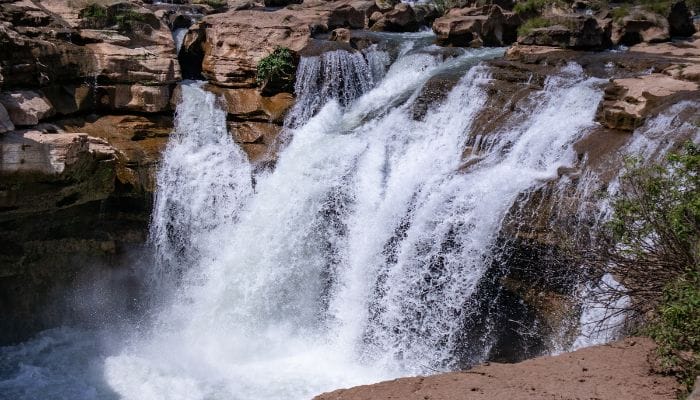
Jamjir Waterfall is a tranquil retreat for nature lovers. The waterfall, surrounded by lush greenery and rugged terrain, offers a stunning natural spectacle, especially during the monsoon season when the flow is robust. The cascading waters create a serene atmosphere, perfect for relaxation, photography, and enjoying a peaceful day out. The surrounding area is also ideal for picnics and short hikes, making it a great spot for a leisurely escape into nature.
18. Captive Wilds of Devalia Park – Lions in an Enclosed Sanctuary
 Image Source
Image SourceDevalia Park is a well-designed wildlife sanctuary that provides an excellent opportunity to observe the rich biodiversity of the region. This enclosed park offers a safe and controlled environment to view Asiatic lions and other wildlife, making it a perfect destination for those who may not wish to venture into the larger national park. Visitors can enjoy guided tours, which provide insights into the park’s flora and fauna, and educational exhibits that highlight conservation efforts. Devalia Park is ideal for families, wildlife enthusiasts, and anyone looking to experience the thrill of a safari in a more accessible setting.
Best Time to Visit in Junagadh
Winter Romance (October to March)
The winter months from October to March herald the best time to visit Junagadh, as cooler temperatures and clear skies create perfect conditions for exploring the city’s historic treasures. The pleasant climate allows for leisurely walks through ancient forts and temples without the discomfort of extreme heat. This season, offering a respite from the scorching summers that follow, is ideal for tourists to immerse themselves in outdoor activities and cultural festivals like the Bhavnath Fair in February. Undoubtedly, winter in Junagadh opens opportunities to discover the full extent of its allure in the most comfortable of settings.
| Aspect | Details |
| Temperature | 15°C to 25°C (59°F to 77°F) |
| Weather | Cool and clear skies; ideal for outdoor activities. |
| Activities | Exploring forts, temples, and attending cultural festivals. |
| Festivals | Bhavnath Fair in February. |
| Tips | Wear layers; enjoy outdoor sightseeing comfortably. |
Rainy Respite (June to September)
During the monsoon, Junagadh is bathed in a fresh, verdant splendor, as the rain replenishes the landscape, bringing with it an air of vitality. Visitors who don’t mind getting a bit wet will find the region transformed, with its waterfalls and hillsides coming alive in a swell of lush foliage. The rains paint the city with vibrant colors, making the natural and historical sites feel more dramatic and inviting. Sightseeing can still be enjoyed, though with some interruption from showers. Travelers keen on experiencing Junagadh’s monsoon magic should pack appropriately for rain and be ready for a mesmerizing, albeit damp, adventure.
| Aspect | Details |
| Temperature | 25°C to 30°C (77°F to 86°F) |
| Weather | Lush, green landscape; frequent rain showers. |
| Activities | Enjoy scenic beauty, waterfalls, and vibrant landscapes. |
| Challenges | Rain may interrupt sightseeing; pack rain gear. |
| Tips | Pack waterproof clothing and an umbrella; be prepared for wet conditions. |
Summertime Sojourn (April to June)
During the summer, Junagadh experiences intense heat, with temperatures soaring, which can make sightseeing a challenging affair. The sun beats down relentlessly, and the scorching climate typically dissuades tourists from outdoor activities during peak daytime hours. Travelers who venture to Junagadh in this season are advised to plan their excursions during the cooler mornings or late afternoons. It’s essential to stay hydrated, wear sun protection, and possibly consider indoor attractions such as museums during the hottest parts of the day. While summer is the least advisable time to visit, it can offer fewer crowds and greater opportunities for solitude at popular landmarks.
| Aspect | Details |
| Temperature | 30°C to 40°C (86°F to 104°F) |
| Weather | Hot and dry; intense heat. |
| Activities | Best for early mornings or late afternoons; consider indoor attractions. |
| Challenges | High temperatures can be uncomfortable; limit outdoor exposure. |
| Tips | Stay hydrated; use sun protection; plan for cooler parts of the day. |
Explore Gujarat: Wildlife, Attractions, Temples, and Best Visiting Times
Best Time to Visit Gir National Park: Planning a visit to Gir National Park? Find out the ideal times to explore this wildlife haven to make the most of your trip. Discover the best seasons for safari adventures and wildlife spotting by reading about the best time to visit in Gir National Park.
Resorts in Gir: For a comfortable and immersive stay near Gir National Park, explore a range of resorts that offer modern amenities and stunning views of the surrounding landscape. Whether you’re looking for luxury or a more rustic experience, you’ll find options that cater to every preference. Discover top choices and book your stay by visiting resorts in Gir.
Wildlife Sanctuaries in Gujarat: Discover the diverse wildlife sanctuaries in Gujarat, each offering a unique glimpse into the region’s rich fauna. Explore renowned spots and learn about the best places to witness majestic animals in their natural habitats. For detailed information, visit wildlife sanctuaries in Gujarat.
Things to Do in Gujarat: Gujarat is brimming with exciting activities and attractions that cater to every interest. From historical sites to natural wonders, find out what makes this state a must-visit destination. To learn more about the best experiences and activities, check out things to do in Gujarat.
Famous Temples in Gujarat: Gujarat is home to several renowned temples that are not only places of worship but also architectural marvels. Explore the most famous temples and their cultural significance. For more insights into these sacred sites, read about famous temples in Gujarat.
FAQs on Tourist Places to Visit in Junagadh
What is the famous of Junagadh?
Junagadh, a gem tucked away in Gujarat, is famous for an array of enthralling attractions, from the sublime Somnath Temple by the Arabian Sea offering spiritual solace, to the resplendent Uperkot Fort, etching the city’s historical saga in stone. Beyond its borders, pilgrims find peace at the Shri Swaminarayan Mandir Junagadh, an exquisite emblem of the Swaminarayan Sampraday’s spiritual heritage. Nature-lovers and history enthusiasts alike marvel at Junagadh’s tapestry of wildlife, vibrant landscapes, and storied monuments, securing its place as a cultural nexus that resonates with visitors worldwide. Whether basking in the tranquility of Porbandar Beach, traversing the historic ramparts of Diu Fort, or embarking on a spiritual journey to Dwarka, Junagadh serves as a gateway to an enriching Gujarati adventure.
Is one day enough for Junagadh?
One day in Junagadh can be quite rushed given its wealth of sights to explore. However, if pressed for time, it’s possible to visit the most prominent attractions such as the Uperkot Fort, Mahabat Maqbara, and Girnar Hill. To truly appreciate the local culture and history, an additional day or two would allow for a more immersive experience, including a trek on Mount Girnar and a safari in Sasan Gir National Park. For a comprehensive exploration, plan your stay with extra time, especially to witness the scenic beauty at a relaxed pace.
What are the top sightseeing places in Junagadh?
The top sightseeing places in Junagadh include the ancient Uperkot Fort offering stunning vistas; this site is a cornerstone on any sightseeing tour of the region. After losing its importance historically, it now serves as a testament to the region’s storied past. The architectural wonder of Mahabat Maqbara and the spiritually significant Girnar Hill are also crucial stops on any well-planned itinerary exploring the heritage of Saurashtra. Nature enthusiasts must visit Sasan Gir National Park to see the Asiatic lions. The Edicts of Ashoka provide a historical deep dive, while the Sakkarbaug Zoological Garden is a treat for animal lovers. For a touch of tranquility, Damodar Kund’s serene waters and Mount Girnar’s temples offer peace and reflection. Each location encapsulates a facet of Junagadh’s rich cultural and natural heritage.
Remark
Junagadh is a hidden gem in the tapestry of India’s tourist destinations, offering a profound journey through history, nature, and spirituality. Each attraction in Junagadh is a thread in the city’s cultural fabric, presenting a narrative that spans centuries and civilizations. For those seeking to unravel the enigma of India’s past, witness the majesty of nature, or embark on a spiritual quest, Junagadh provides a platform for diverse experiences. Its charm lies in its ability to blend the echoes of antiquity with the thrumming life of the present, making it an unforgettable destination for all who traverse its lands
